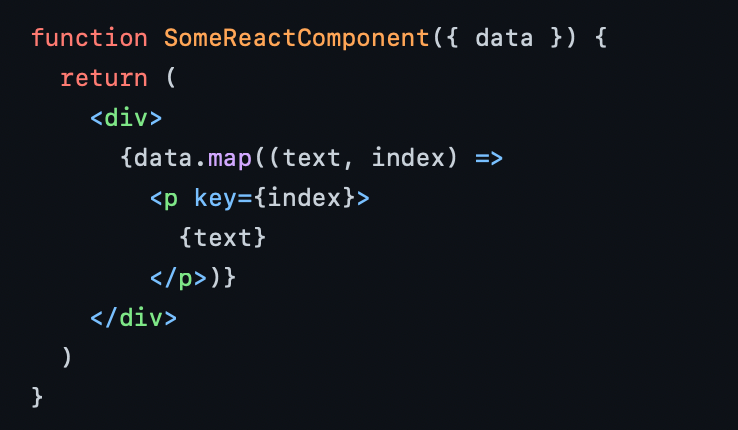React Unique Keys for Array Children
Learn how to use unique keys effectively for array children in React.js to ensure optimal performance, efficient updates, and a seamless user experience.
Learn how to use unique keys effectively for array children in React.js to ensure optimal performance, efficient updates, and a seamless user experience.
In React, managing lists efficiently is crucial for optimal performance. Understanding the role of unique keys is essential in this process. Let's explore the importance of keys, how to choose them effectively, and implement them correctly in your React code. We'll also highlight common pitfalls to avoid, ensuring your lists render smoothly and maintain stability. By following these guidelines, you'll create React applications that deliver a seamless user experience.
When working with lists in React, you'll often encounter the concept of "keys." These keys play a crucial role in helping React efficiently update and render lists, ensuring optimal performance and preventing unexpected behavior. Let's break down the steps to effectively use keys in your React applications:
1. The Importance of Keys:
2. Choosing the Right Key:
3. Implementing Keys in Code:
Here's how to add keys to list items in your React components using JavaScript:
function MyList(props) {
const items = props.data;
return (
<ul>
{items.map((item) => (
<li key={item.id}>
{item.name}
</li>
))}
</ul>
);
}In this example:
items is an array of objects, each with a unique id property.map function iterates over the items array.<li>) is created.key prop is set to item.id, ensuring each item has a unique and stable identifier.4. Avoiding Common Pitfalls:
5. Key Takeaways:
Remember, using keys correctly is crucial for building performant and reliable React applications with dynamic lists.
This code demonstrates the use of unique keys in a React list component. It defines a list of items, each with a unique ID, and renders them as list items using the map function. The key prop is set to the item's ID to ensure efficient updates when the list changes. A button is included to add new items to the list, demonstrating how React uses keys to optimize rendering.
import React, { useState } from 'react';
function MyList() {
// Sample data with unique IDs
const [items, setItems] = useState([
{ id: 1, name: 'Apple' },
{ id: 2, name: 'Banana' },
{ id: 3, name: 'Orange' },
]);
// Function to handle adding a new item
const handleAddItem = () => {
const newId = items.length + 1;
const newItem = { id: newId, name: `Item ${newId}` };
setItems([...items, newItem]);
};
return (
<div>
<ul>
{items.map((item) => (
<li key={item.id}>
{item.name}
</li>
))}
</ul>
<button onClick={handleAddItem}>Add Item</button>
</div>
);
}
export default MyList;Explanation:
Import React and useState: We import React and useState hook to manage the state of our list items.
Sample Data: We define an initial state items with an array of objects, each having a unique id and a name.
handleAddItem Function: This function is triggered when the "Add Item" button is clicked. It creates a new item with a unique ID and adds it to the items array using the spread operator and setItems.
Rendering the List: We use the map function to iterate over the items array and render each item as a list item (<li>).
Key Prop: The crucial part is setting the key prop to item.id for each list item. This ensures React can efficiently identify and update individual items when the list changes.
Adding Items: When a new item is added, React uses the unique keys to determine that only the new item needs to be rendered, optimizing performance.
Key Points:
id, which is used as the key.id remains stable even if the order of items changes.This example demonstrates the practical implementation of using unique keys in a React list, ensuring efficient rendering and a smooth user experience.
Beyond the Basics:
react-window or react-virtualized for large lists to optimize rendering performance.Advanced Use Cases:
Debugging Key Issues:
Remember, understanding and effectively using keys is an ongoing learning process. As you encounter more complex scenarios and edge cases, continue to refine your approach to ensure optimal performance and user experience in your React applications.
| Step | Description |
|---|---|
| Importance of Keys | - Keys help React identify changes in lists during reconciliation, leading to efficient updates and rendering. Without keys, React might unnecessarily re-render the entire list. |
| Choosing the Right Key | - Keys must be unique within the list to avoid rendering issues. - Keys should be stable and not change between renders; avoid using indexes. - Use unique and stable identifiers from your data as keys (e.g., database IDs, usernames). |
| Implementing Keys in Code | - Use the key prop within list items during rendering. - Example: <li key={item.id}>{item.name}</li>
|
| Avoiding Pitfalls | - Don't use index as key: This can cause performance issues if the list order changes. - Don't use random keys: This defeats the purpose of stable identifiers and can lead to unnecessary re-renders. |
| Key Takeaways | - Keys are crucial for efficient list rendering in React. - Choose unique and stable keys. - Avoid using indexes or random values as keys. |
By understanding the role of unique keys in React lists, you've taken a significant step towards building efficient and performant React applications. Remember, keys are not just a minor detail; they are fundamental to how React manages lists and ensures smooth updates. By choosing appropriate keys and avoiding common pitfalls, you'll create React applications that deliver a seamless user experience, even with dynamic and complex lists. As you continue your React journey, keep exploring advanced use cases and best practices for keys to further enhance your skills and build exceptional user interfaces.
 Understanding unique keys for array children in React.js | Sentry | The problem When you render an array of objects, you need to provide a unique key property for each element rendered for the array item. This tells React…
Understanding unique keys for array children in React.js | Sentry | The problem When you render an array of objects, you need to provide a unique key property for each element rendered for the array item. This tells React… Lists and Keys – React | A JavaScript library for building user interfaces
Lists and Keys – React | A JavaScript library for building user interfaces React: Each child in a list should have a key prop | Medium | If you’ve worked with React, you probably know this warning. But what is the right way to fix it? Does key={index} work? Let’s find out!
React: Each child in a list should have a key prop | Medium | If you’ve worked with React, you probably know this warning. But what is the right way to fix it? Does key={index} work? Let’s find out! Understanding Unique Keys for Array Children in React.js | React.js uses a number of unique concepts that can initially seem a bit confusing. One such concept is the use of keys, particularly when working with componen...
Understanding Unique Keys for Array Children in React.js | React.js uses a number of unique concepts that can initially seem a bit confusing. One such concept is the use of keys, particularly when working with componen... REACT: generating unique keys - JavaScript - SitePoint Forums ... | I understand that it is best practice when gearing a list of items in REACT to assign a unique, stable, key to each item in order to make redeeming more efficient. I also understand that this in order to be stable, this key should NOT be generated based on something like the item’s index on the source array. I was wondering if any REACT expert might have a go-to technique for generating stable keys keys , not based on the index , when you have , a generic, non-unique, array? Example, say ...
REACT: generating unique keys - JavaScript - SitePoint Forums ... | I understand that it is best practice when gearing a list of items in REACT to assign a unique, stable, key to each item in order to make redeeming more efficient. I also understand that this in order to be stable, this key should NOT be generated based on something like the item’s index on the source array. I was wondering if any REACT expert might have a go-to technique for generating stable keys keys , not based on the index , when you have , a generic, non-unique, array? Example, say ... BOSC Tech Labs Private Limited on LinkedIn: Understanding ... | Hello Readers!
BOSC Tech Labs Private Limited on LinkedIn: Understanding ... | Hello Readers!Today, we are going to discuss about Understanding unique keys for array children in React.js
Read the article here: https://lnkd.in/dZ-bf3Js…